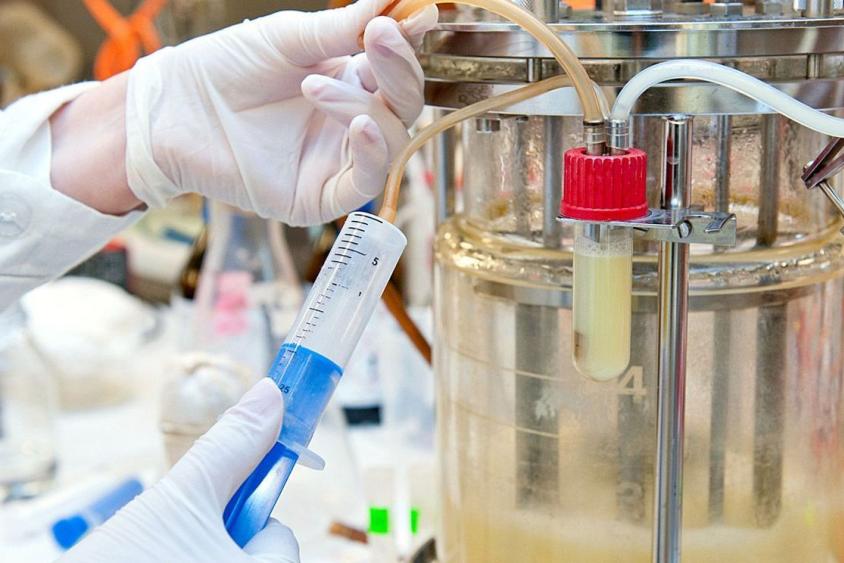Automation Will Dominate Single-Use Bioprocessing within the Next Five Years

In the next few years, single-use bioprocessing will be more automated and more common, with closed systems supporting continuous manufacturing for upstream and downstream activities.
The transition is well underway, driven by personalized medicine’s need for increasing numbers of low-volume batches of cell and gene therapies as well as monoclonal antibodies.
Upstream bioprocessing currently accounts for about 75 percent of the market, according to Vision Research Reports, but that’s changing. “Single-use technology is moving downstream into filtration systems and even into chromatography,” Charles L. Cooney, Robert T. Haslam Professor Emeritus in the MIT Department of Chemical Engineering, tells Lab Manager.
By supporting up- and down-stream processing, “It enables you to connect the processes together, bioreactor to cell recovery, with plug-and-play ease,” Cooney says. Therefore, manufacturers can use a large room rather than needing separate rooms for processing. Consequently, “they can perform bioprocessing at a meaningful scale with less capital expenditure.”
The next generation of single-use systems
Automation and integration will feature prominently in the next generation of single-use systems. Currently, fully automated systems can deliver flowrates and pressure rates to process a 2,000 L bioreactor. These systems will also have Raman spectroscopy technology added in-line to provide real-time Raman analysis in single-use bioreactors and downstream systems. With the appropriate software, these systems can be connected and controlled while analyzing their process data in-person or remotely.
This vision of the Facility of the Future features the convergence of multiple technologies in a single-use, holistic, digital environment that is capable of running continuously. To do this, companies are developing systems “that intensify and compress unit operations, such as smart consumables with integrated sensors, and a digital software suite that provides integrated process control and analytics, and a connected network that allows manufacturers to receive data and support directly from our process and product experts,” says Mike Felo, head of bioprocessing marketing at MilliporeSigma. That’s a huge change from 15 years ago when simple single-use assemblies used tubing, bags, and filters for low-risk applications like media and buffer storage and intermediate filtration.
Since then, Felo says, “new components, such as sterile connectors, single-use pumps, single-use sensors and innovative filtration technologies have been launched.” Grand View Research, predicts market growth of 16.2 percent for single-use bioprocessing probes and sensors between 2021 and 2028.
Mag-lev mixers and advanced technologies to measure flow and control pumping can support closed processing and continuous manufacturing. Such critical applications as final fill now can be accomplished in a single-use bioprocessing environment.
Meeting bioprocessing challenges
As single-use processing becomes more popular, it is changing the challenges associated with bioprocessing. For example, Felo says, “Validation activities have shifted from the drug developer to the single-use supplier. Therefore, it’s critical to select a single-use supplier with experience, expertise, and a strong quality management system.”
Interoperability of system components remains an issue. Because many vendors provide proprietary components, like films, filters, and connectors, it can be challenging to have multiple sources for the consumables required for these processes.
Consequently, many companies manage their risks by holding large quantities of stock on hand or by performing tests to determine whether two different products are interchangeable. In the process, Felo says, “Users are trying to standardize and harmonize their single-use assembly part numbers and to build a library of preferred components.”
Process intensification is one of today’s limitations that technology manufacturers are addressing. Cooney discusses oxygen transfer as an example: “Enhancing oxygen transfer has to do with mixing and the ability to blend oxygen with air before it goes into the reactors.” But, he says, “The ability to do that is limited because single-use technology bags can’t withstand high pressure.”
Additional challenges include heat transfer as processes intensify, along with extractables and leachables that may contaminate processes. As materials continue to improve to better deal with heat and solvents and to become more stable themselves, these concerns will dissipate.
Downstream, Cooney sees interest in membrane chromatography and flow-through chromatography for use in final purification streams, and the implementation of continuous manufacturing in closed single-use systems. “There’s a lot of work being done to get all the pieces to work together for continuous manufacturing,” he says.
Sustainability in single-use bioprocessing
Researchers in academia and corporate environments are looking at sustainability, too. “On one hand, you’re putting more plastic into the environment, but on the other, you’re decreasing energy and water consumption, so you need to take a holistic view to determine the impact. A lot of good work is being done in that area,” Cooney says.
Regulatory responsibility will shift, too. “As new advanced technologies are launched and used in the manufacturing of therapeutics, the challenge will shift to regulatory acceptance,” Felo predicts. For example, new materials will require a thorough risk assessment that includes leachables and extractables. New connectors that enable fully-closed processing will require a means of sterility validation.
Likewise, he continues, “new sensing technologies that enable continuous processing and real-time process monitoring and control will need to demonstrate comparability to off-line analytics.”
Additionally, Felo says, for continuous processing, “Drug manufacturers will need to redefine what they mean by ‘lot’ and ‘batch,’ because there will no longer be a discreet start and stop to the process.”
Single use bioprocessing is “a very important addition to our tool set. It doesn’t mean stainless steel won’t be important, but single use gives us more freedom,” for small volume production, Cooney says.


